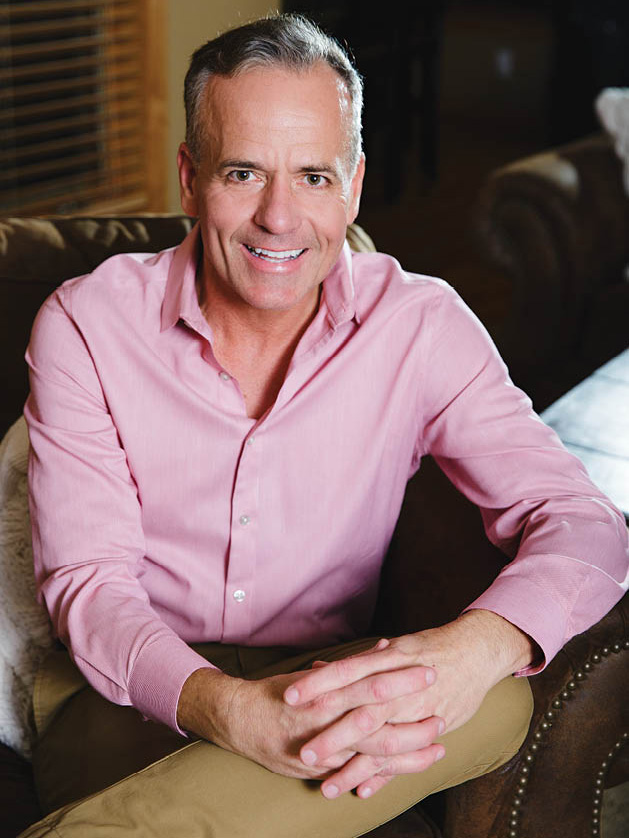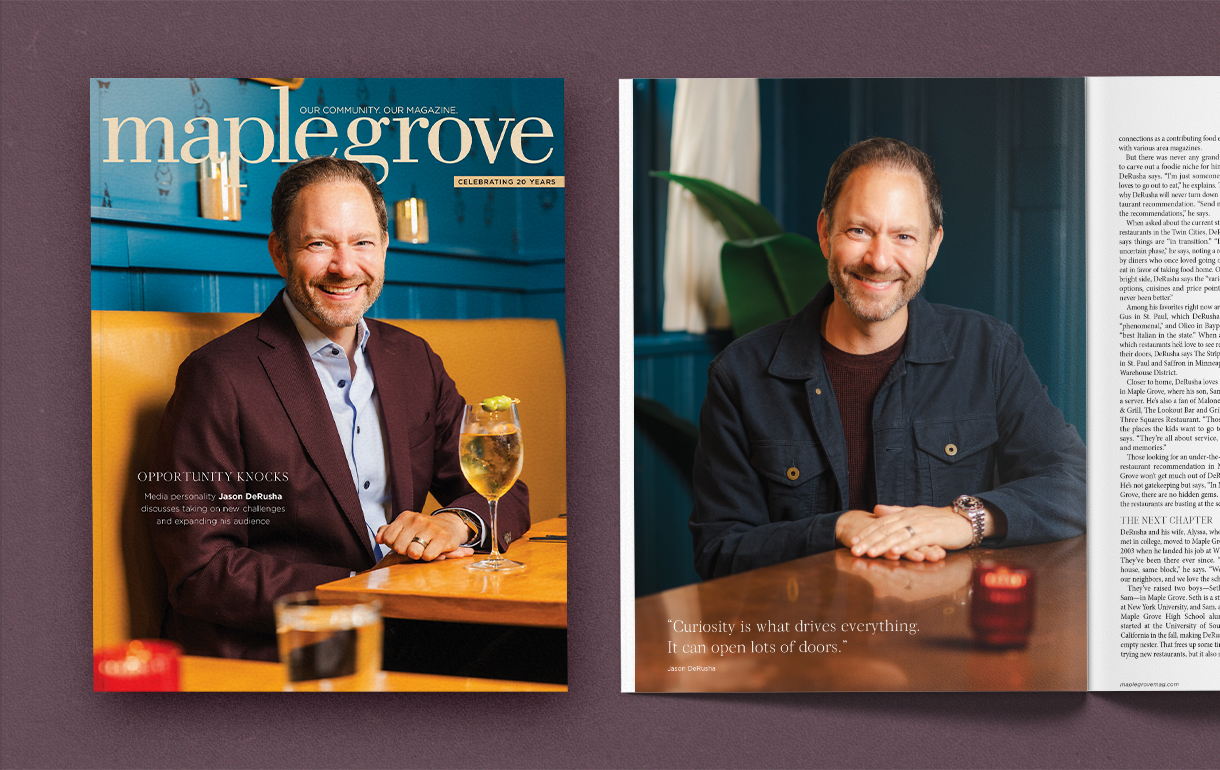
Ken Barlow in his home. Photos: Rachel Nadeau
KSTP meteorologist Ken Barlow shifts the prevailing winds of mental illness.
On October 12th of 2012, KSTP meteorologist Ken Barlow surprised himself. With trembling hands, during an appearance on the Twin Cities Public Television show Almanac, Barlow made public that he lives with bipolar disorder.
He’d said it out loud, in public, a month earlier during a National Alliance on Mental Illness (NAMI) event, but to make it known to TV viewers that their favorite friendly weather guy dealt with mental illness was a different thing all together.
His wife and kids were surprised too. “The day he came home from the NAMI walk and told us that he had made this announcement we were shocked,” says Ken’s wife Theresa. They had carefully kept it “in the family” for years. Ken even had Theresa visit the pharmacy to pick up his medicine, for fear that someone would see him.
Misconceptions about bipolar disorder put Barlow in very real jeopardy of losing his job and suddenly making those around him noticeably uncomfortable. But instead, he found that dark years of fear were diminished in the bright light of honesty.
Atmospheric Pressure
Barlow knew there was something “wrong” from the time he was a kid. And, he had an early passion for what was happening outside his window.
“I knew I wanted to be a meteorologist since I was 7,” he says. He grew up on the East Coast and lived through Hurricane Agnes in the summer of 1972. A large tree in the neighborhood had been completely uprooted and tossed onto its side.
“I thought it was so cool,” recalls Barlow.
From that moment on he spent time at the library reading about weather. He had a weather map on his bedroom wall, “I pretended I was on TV,” he says with a grin.
But he also spent time in that bedroom feeling inexplicable sadness, either not wanting to get up or bouncing off the walls. “That’s just the way I was,” he says.
Barlow took his concerns about his manic behavior more seriously during college. He was a straight “A” student with a strong streak of perfectionism and an addictive bent for running eight miles a day, eating cheese sandwiches and doing a lot of homework.
He consulted a doctor, which he had done previously, too. “He gave me an inhaler and said I had August allergies,” Barlow says.
But the unsettling behavior continued.
“Once, in a manic phase, I went out and bought a $5,000 pool table…I don’t even play pool!” Barlow says. He explains it as something he could not control. “I knew, as I was buying it, that Theresa was going to kill me. And she did!”
Cloud Cover
After years of doing what he loves on air at KARE 11—“surrounded by legends” he says of his coworkers—with a house, two cars and a beautiful family, one day he found that he couldn’t get out of bed. “When I’d get up, in the shower, the water hurt,” he says.
Perhaps in an unconscious attempt to set right the feeling that something was still wrong, Barlow took an irresistible job offer from a station in Boston, where he could move his wife and kids closer to family.
However, the move away from Maple Grove proved too rough on their children. Theresa moved back so their daughter could finish her junior year of high school in Minnesota, which left Ken alone with no one to modify his erratic behavior and eating patterns.
“In Boston, the stress triggered a full-blown episode,” Barlow says. “I would run on the treadmill at three in the morning and eat only yogurt and grapefruit, and I was flying back and forth to Minnesota every weekend. Theresa knew there was something wrong before I got home because I was speaking so fast on the phone.”
In Boston, he saw a doctor again.
“I thought they’d finally find something, a brain tumor or something,” Barlow says. He knew it was serious when they wouldn’t discuss it over the phone. At the follow-up appointment, he was told that the MRI was normal and he had vertigo. “I think the doctor misinterpreted my saying I had a buzzing feeling in my head as dizziness,” Barlow says. He was given a prescription and sent home.
Back in Boston, he finally ended up on the bedroom floor on the phone to his wife letting her know that he was in real trouble. The next thing he remembers is a fireman standing over him in the bedroom. And then, nothing. Until, he saw Theresa’s face and wondered how she had arrived from Minnesota so quickly.
Sometimes life offers a lightning bolt, and this one was Ken’s. Theresa informed him that he was in the hospital, in the psychiatric ward.
“I was angry,” he says. He’d lost a week of life lying in a semiconscious state. And when he heard his diagnosis, it was clear that he’d lost years of life going undiagnosed. “For 25 years, I could have been in a much better way,” he says.
“When someone gets told they have this illness it is incredibly overwhelming and scary,” Theresa says. “Getting the actual diagnosis was a good thing, but a very hard thing, too. The difference for Ken came when he accepted the diagnosis.”
After a week , Barlow quietly shared the diagnosis with his mother, over the phone. She revealed that Ken’s father had been diagnosed with bipolar disorder at the age of 60, five years before his death.
“He was ashamed,” she offered by way of explanation for his father’s silence.
Heat Advisory
This marked the beginning of another new journey for Barlow: living with shame. Ashamed of the label “mentally ill,” disgusted with the public media spin on murderers and violent criminals that lumps all people with mental illness into the same category, he hid for five years.
Decisively, the only way to combat the shame seemed to be acting to bring it into the light, and Barlow did that in high public style. For a man who is very much in the public eye, viewed in thousands of Minnesota homes every day, he was betting that his name recognition would outshine years of negative perception about mental illness; he became a fierce advocate for proper understanding of bipolar disorder. “I was sick of hiding,” he says.
Now, Ken Barlow manages what must seem like a second career. One filled with speaking engagements and an aspect he hadn’t understood might follow such a startling announcement: support.
Barlow speaks to medical students at the U of M each semester, helping them consider the ways that bipolar arrives in the disguise of other ailments. He shares his story with civic groups and high school assemblies.
“It’s exhausting every time I talk about it. I relive it. But it’s worth it,” he says .
The memory of a recent presentation at Lakeville North High School brings Barlow to tears as he tells, in fits and starts, how the final Q & A period changed tenor quickly when a young girl stood in front of her classmates to reveal that she dealt with depression and anxiety. And, in what can be one of the toughest environments a teenager can face, she was applauded and supported.
Future Forecast
Barlow is, like many people with bi-polar, managing his disorder, with medication and his family’s support.
“We are not murderers, we are just the people next door,” Barlow says.
In his zeal to let others know that bipolar is “livable”, he knows to keep his own activities consistent and measured, not overbooking himself while also leaving necessary time for rest.
“I still don’t like being alone,” Barlow says. “I am hypersensitive about becoming manic.”
His kids are fully aware of the hereditary nature of the disorder and will almost surely face a less judgmental world if they ever show symptoms, in no small part due to the efforts of their father.
Barlow and his family weather this particular storm gracefully, and we predict fairer skies for other families facing similar threatening storm systems because of the light that Ken Barlow has courageously shone on the true reality of living with bipolar disorder.
Off the Cuff with Ken Barlow
Q: Tell us about your family growing up.
A: I grew up in Rhode Island, in the projects. My family was on welfare and food stamps, but we were happy. I had four brothers, two older and two younger.
Q: How has your employer, Hubbard Broadcasting, dealt with the news of your illness?
A: They couldn’t be better. They’ve gone above and beyond to support me.
Q: How about coworkers?
A: Coworkers never suspected. Later they would tell me that if they’d only known, they would have tried to help, but I didn’t even know it myself.
Q: You’d absolutely fail at being…?
A: A singer, professional bowler or…a waiter. I’d make a horrible waiter! They are amazing, I don’t know how they do it. I would never have the patience to deal with people.” “Ken is friendly, but not a patient person,” agrees his wife Theresa.
Q: If you weren’t a weather forecaster?
A: I would be a senator. I love politics. I’m a political junkie.

Ken and his wife, Theresa, who has been incredibly supportive throughout their marriage.
The Barlows recently worked on a video with Mayo Clinic; the video received honors for its look at their family’s journey with bipolar disorder.






















